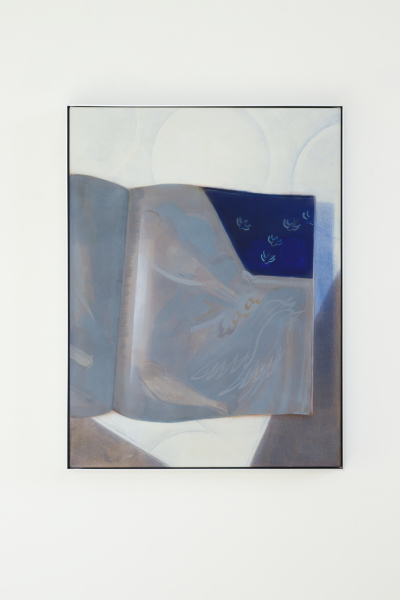-
“Snippets in Stone”, acrylic and oil on canvas, 60x45cm, 2022
As an academically trained conservator and restorer, Sister I. has been practicing the trade since the early aughts. But the medium of her other degree —painting—is where she is most comfortable. Throughout her practice, Sister I. builds bridges between the imagination of the past and the contemporary sensibility of the nowthrough a body of work that is driven by (micro)histories, personal-collective memory, and poetics.
A fact, piece of data, or even a random textual snippet will attract the attention of Sister I and drive her work. However, the outcome tends to balance on the verge of fiction, speculation, and visual uncanniness. Sister I. is captivated by a murky, muddy reality which is translated into a unique visual language where uneasy strangeness and modest eccentricity meets.
In her restoration practice, Sister I. encounters material which is, for the most part, in various stages of degradation and fragility—or even hidden. Whereas in her more “speculative” artistic practice the starting point for her paintings has nothing to do with the painting. Built from the ground up—from scratch and stitched together as a collage—her paintings evoke a manipulated sense of the past. Here, collage is a glitch, a tool to stitch the dispersed, related/unrelated fragments, stories, mediums, and attitude into a work. When finished, Sister I’s creations become a quasi-meme with multiple, layered stories told at once.
(meet Sister N.)
Bluetooth (Sister N.) is a new body of work by Sister I. based on an internal, comradely instinct of hers to gesture to the skillfulness of Sister N., a medieval female artist who has been undeservedly forgotten. Sister I. tracks down a story of a brilliant blue lapis lazuli found not long ago by archeologists in the 1,000-year-old dental tartar of a skull in the soil of Dalheim, Germany. According to radiocarbon dating, teeth containing blue particles belonged to a woman, aged between 45 and 60, she was likely a painter of medieval manuscripts at the women’s monastery.
Made not only by monks, their female counterparts—nuns—also produced laborious and beautiful books. The majority were left unsigned, thus, the women were effectively erased from history. For some, the idea that a woman could have been a painter skilled enough to work with a precious and rare ultramarine pigment raises skepticism. For them, Sister N., a possible aristocrat or noble, did no more than simply kiss an illuminated manuscript. Sister I. chooses to disagree with this premise, and has staged the present exhibition around the notion that Sister N. licked the end of the brush whilst painting before repeatedly touching her final creation.
Isolating in her studio apartment in the Nordic capital for the past two years, Sister I. has immersed herself in the largely untapped territory of medieval manuscripts. By (re)imagining and tracing the story of Sister ’N. she exercised the methods and compositional guidelines found in the medieval illuminations. Sister I. also reminds us that Sister N. may have lived in a brief moment of history when women were emancipated, shortly before they were “rendered” witches destined for burning.
Accordingly, Bluetooth (Sister N.) comprises a series of paintings, prints, sculptural objects and an installation. Here, works are carried out on primed canvas or paper, painted and imprinted with oil, applied with acrylic or a self-made colour pigment. Sister I’s labor and craftsmanship evokes a specific mood where a sense of the presence (of another soul, of another mind, of Sister N.…) suggests a range of themes and stories while at the same time remaining evasive in their appearance and message.
In Bluetooth (Sister N.), illegible handwriting on the margins of the medieval manuscripts meets screen-and-swipe-ready fingers in order to gesture to the skilled hands that operate professionally without ever leaving a trace of an individual. Sister I. “doodles” by laying various paint patterns in reference to the testing operations which were likely to be performed by Sister N. before she wrote, painted, and coloured the manuscripts. Sister I. stacks layers, stirs up surfaces, and rubs them off in order to unlock empathy and internalise a creative and artistic logic.
Finally, Sister I. and Sister N. connect via bluetooth; they share organ music, listen to bird sounds, and discuss devotion and infrastructures of care before parting ways with the sad realisation that in present times, the medieval allegory of Danse Macabre is a grim force yet again.
.
Curator: Zane Onckule
Photo documentation: Ansis Starks
Temnikova & Kasela gallery Tallinn, Estonia
